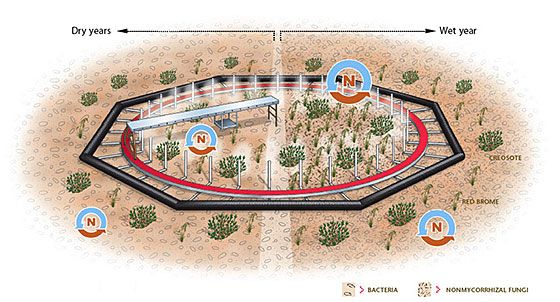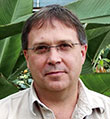Soil in the Mojave Desert and CO2 levels
At Washington State University botanist Dave Evans's study site in the Mojave Desert, just north of Las Vegas, nine rings of PVC pipe supported by thin posts hang above the creosote bushes and burro-weed. Twenty-five yards across and about five feet off the ground, the white rings look like something out of a science-fiction show, a signal to alien landing craft, perhaps. In fact they are part of one of the longest-running experiments ever attempted to try to assess the effects of extra CO2 on natural ecosystems.
The experiment ran for 10 years. Six of the rings served as controls, three with ambient air blown over the plants they surrounded and three "silent," with no blowers. In the three experimental rings, the pipes blew enough CO2 into the area enclosed by each ring to raise the level there to 550 parts per million.
While his colleagues from the University of Nevada assessed how the plants responded, Evans examined the soils and underground organisms. He found that Mojave soil reacted very differently than Gill's grassland soil. In areas of high CO2, it had more nitrogen available for plants and soil microbes to use. But there were a couple of catches. In normal years, most of the extra nitrogen was scarfed up by soil organisms, not plants. And wet years were something else again.
At Dave Evans's study site in the Mojave Desert, plants and soil organisms took little note of added CO2 during dry years (left). The big changes came in a year with high rainfall (right), which spurred the normally water-limited soil organisms to process more nitrogen. But even with plenty of water and more nutrients available, the main plant beneficiaries were invasives such as red brome. The platform extending into the ring allowed Evans to gather samples without walking on the soil or disturbing the plants.

ILLUSTRATION BY AARON ASHLEY

Photo of Dave Evans by Carolyn M. Emerson
R. David Evans, Ph.D. :: Department of Botany, School of Biological Sciences :: Areas of focus include carbon, nitrogen, and water dynamics in terrestrial ecosystems, with an emphasis on responses to global change..
